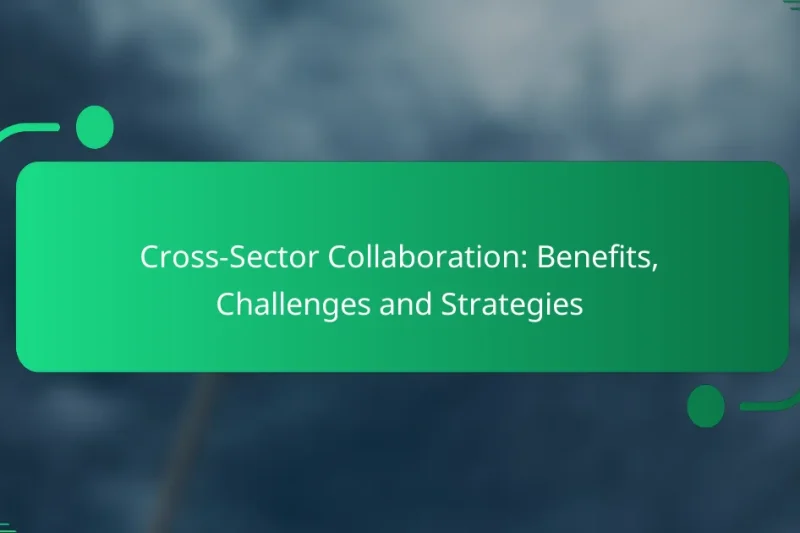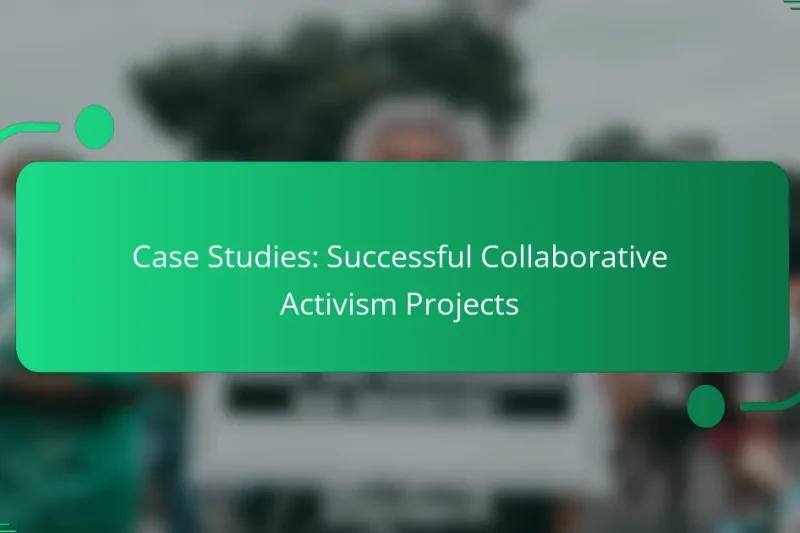Cross-sector collaboration unites diverse organizations to tackle shared challenges, fostering innovation and resource sharing for greater … Cross-Sector Collaboration: Benefits, Challenges and StrategiesRead more
Community Activism Media Projects: Collaborative Strategies
Community activism media projects play a crucial role in raising awareness and mobilizing support for social issues through various media formats. By fostering collaboration among organizations, these initiatives enhance their reach and impact, allowing for a more significant community engagement and ownership. Through strategic partnerships and shared resources, activists can effectively amplify their voices and drive meaningful change.
Conflict Resolution: Strategies for Collaborative Activism Projects
Conflict resolution is vital in collaborative activism projects, as it encourages understanding and cooperation among diverse … Conflict Resolution: Strategies for Collaborative Activism ProjectsRead more
Coalitions: Uniting Activism Groups for Common Goals
Coalitions play a crucial role in enhancing activism by uniting diverse groups around common goals, thereby … Coalitions: Uniting Activism Groups for Common GoalsRead more
Effective Meetings: Facilitation Techniques for Activism Stakeholders
Effective meetings are crucial for activism stakeholders, as they foster communication, engagement, and collaborative decision-making. By … Effective Meetings: Facilitation Techniques for Activism StakeholdersRead more
Success Evaluation: Metrics for Collaborative Activism Initiatives
Success in collaborative activism initiatives hinges on the evaluation of specific metrics that capture engagement, impact, … Success Evaluation: Metrics for Collaborative Activism InitiativesRead more
Case Studies: Successful Collaborative Activism Projects
Successful collaborative activism projects bring together diverse groups to tackle pressing social, environmental, and political issues. … Case Studies: Successful Collaborative Activism ProjectsRead more
Communication Tools: Enhancing Interaction Among Activism Partners
Effective communication tools are essential for activism partners, as they enhance collaboration and streamline project management. … Communication Tools: Enhancing Interaction Among Activism PartnersRead more
What are effective community activism media projects?
Effective community activism media projects are initiatives that leverage various media formats to raise awareness, mobilize support, and foster community engagement around social issues. These projects often utilize storytelling, collaboration, and outreach to amplify voices and drive change.
Documentary films
Documentary films serve as powerful tools for community activism by visually capturing stories and issues that matter to local populations. They can highlight injustices, celebrate cultural heritage, or showcase grassroots movements, making complex topics accessible to a broader audience.
When creating a documentary, consider involving community members in the production process to ensure authenticity and representation. Aim for a runtime that keeps viewers engaged, typically between 30 to 90 minutes, and plan screenings in accessible venues to maximize impact.
Social media campaigns
Social media campaigns are essential for reaching diverse audiences quickly and effectively. They enable activists to share information, mobilize supporters, and create a sense of community around specific causes using platforms like Facebook, Twitter, and Instagram.
To run a successful campaign, define clear goals, use engaging visuals, and create shareable content. Hashtags can help increase visibility, while regular updates keep followers informed and engaged. Monitor analytics to assess the campaign’s reach and adjust strategies as needed.
Community radio stations
Community radio stations provide a platform for local voices and issues, fostering dialogue and awareness on social matters. These stations often focus on underrepresented communities, offering news, music, and talk shows that reflect local culture and concerns.
Establishing a community radio station requires collaboration with local stakeholders and adherence to broadcasting regulations. Consider training volunteers to produce content and engage listeners through call-in shows or community events to strengthen ties and encourage participation.
Collaborative art installations
Collaborative art installations engage community members in the creative process, allowing them to express their experiences and perspectives on social issues. These projects can take various forms, such as murals, sculptures, or interactive exhibits that invite public participation.
When planning an installation, involve local artists and community groups to ensure the project resonates with the audience. Choose locations that are accessible and visible to maximize engagement, and consider hosting events to unveil the artwork and discuss its significance.
Public forums and workshops
Public forums and workshops create spaces for dialogue and education around community issues, encouraging participation and collaboration. These events can help build relationships among community members and empower them to take action on shared concerns.
To organize effective forums, select accessible venues and promote the events widely. Structure discussions to allow for diverse viewpoints and provide resources for participants to learn more about the topics. Follow up with action plans or additional workshops to maintain momentum and engagement.
How can community organizations collaborate on media projects?
Community organizations can collaborate on media projects by forming strategic partnerships that leverage shared resources, skills, and networks. This collaboration enhances the reach and impact of media initiatives while fostering a sense of community ownership and engagement.
Partnerships with local businesses
Local businesses can play a crucial role in community media projects by providing funding, resources, or venues for events. Collaborating with businesses can also enhance visibility and credibility, as they often have established customer bases that can be tapped into for outreach.
For example, a community organization might partner with a local café to host a film screening, where the café promotes the event to its patrons. This not only supports the project financially but also encourages community members to engage with both the media initiative and the business.
Engagement with schools and universities
Schools and universities are valuable partners in media projects, offering access to students, faculty, and facilities. Engaging students can bring fresh perspectives and innovative ideas, while faculty can provide expertise and mentorship.
Consider organizing workshops or internships where students can contribute to media production, gaining practical experience while benefiting the community. This collaboration can also enhance educational outcomes by connecting classroom learning with real-world applications.
Involvement of non-profit organizations
Non-profit organizations often share similar missions and goals, making them ideal collaborators for media projects. By working together, these organizations can pool resources, share knowledge, and reach wider audiences.
For instance, a health-focused non-profit might collaborate with a media organization to create informative content about local health issues. This partnership can amplify the message and ensure that it reaches the intended audience effectively, fostering community awareness and action.
What are the benefits of collaborative media strategies?
Collaborative media strategies enhance the effectiveness of community activism by pooling resources, increasing visibility, and fostering deeper engagement. These approaches leverage the strengths of multiple organizations to create a more significant impact on social issues.
Increased visibility for causes
Collaborative media strategies significantly boost the visibility of social causes by combining the audiences of participating organizations. This collective outreach can lead to a broader awareness and understanding of issues that might otherwise go unnoticed.
For example, a joint campaign between local nonprofits can utilize various media platforms, such as social media, blogs, and community events, to amplify their message. This multi-channel approach can reach thousands more than individual efforts alone.
Enhanced community engagement
Engaging the community is crucial for the success of activism, and collaborative media strategies foster this engagement by creating inclusive platforms for dialogue. When multiple organizations work together, they can host events or discussions that resonate with diverse community members.
Utilizing tools like community forums or social media groups allows for real-time interaction and feedback, making residents feel more connected to the causes. This engagement can lead to increased volunteer participation and support for initiatives.
Resource sharing among organizations
Collaboration allows organizations to share resources, such as funding, expertise, and technology, which can enhance the overall effectiveness of their campaigns. By pooling resources, groups can reduce costs and maximize their impact.
For instance, two organizations might share a marketing budget to create a joint advertising campaign, allowing them to reach a larger audience without incurring significant expenses. Additionally, sharing knowledge and best practices can lead to more innovative solutions to common challenges.
What tools support community activism media projects?
Community activism media projects benefit from a variety of tools that enhance collaboration, communication, and design. Key platforms like Canva, Zoom, and Facebook provide essential functionalities that help activists effectively engage their communities and promote their causes.
Canva for graphic design
Canva is a user-friendly graphic design tool that allows community activists to create visually appealing materials such as flyers, posters, and social media graphics. With a wide range of templates and design elements, users can produce professional-quality visuals without needing extensive design experience.
To maximize Canva’s potential, consider using its collaboration features, which enable team members to work on designs simultaneously. This can streamline the creative process and ensure that all voices are heard. Additionally, be mindful of the dimensions required for different platforms to ensure your designs fit perfectly.
Zoom for virtual meetings
Zoom is a popular platform for hosting virtual meetings, making it ideal for community activism projects that require remote collaboration. It supports video conferencing, screen sharing, and breakout rooms, allowing for effective discussions and brainstorming sessions among team members.
When using Zoom, ensure that all participants have a stable internet connection to avoid disruptions. It’s also beneficial to establish a clear agenda before meetings to keep discussions focused and productive. Consider recording sessions for those who cannot attend, ensuring everyone stays informed.
Facebook for community outreach
Facebook serves as a powerful tool for community outreach, enabling activists to connect with a broad audience. Through pages, groups, and events, users can share information, mobilize supporters, and foster community engagement around specific causes.
To effectively use Facebook for outreach, regularly post engaging content that encourages interaction, such as polls or questions. Utilize Facebook Events to organize gatherings or campaigns, and consider targeting specific demographics to reach the most relevant audience. Be aware of privacy settings and community guidelines to maintain a safe environment for discussions.
What are the challenges faced in community activism media projects?
Community activism media projects often encounter significant challenges that can hinder their effectiveness. Key issues include limited funding, resistance from community members, and difficulties in coordinating efforts among diverse groups.
Lack of funding and resources
Securing adequate funding is a primary challenge for community activism media projects. Many initiatives rely on grants, donations, or crowdfunding, which can be unpredictable and insufficient to cover operational costs.
To mitigate this issue, project leaders should explore multiple funding sources, including local businesses, government grants, and partnerships with non-profit organizations. Establishing a clear budget and demonstrating the project’s impact can also attract potential funders.
Community resistance to change
Resistance from community members can pose a significant barrier to the success of activism media projects. Individuals may be skeptical of new ideas or fear that changes will disrupt their way of life.
To address this resistance, it is crucial to engage the community early in the project. Conducting surveys, hosting informational meetings, and incorporating feedback can help build trust and foster a sense of ownership among community members.
Coordination among diverse groups
Effective coordination among various stakeholders is essential for the success of community activism media projects. Different groups may have conflicting interests or communication styles, complicating collaboration.
To improve coordination, project leaders should establish clear roles and responsibilities, utilize collaborative tools, and hold regular meetings to ensure all voices are heard. Building relationships among stakeholders can also enhance teamwork and facilitate smoother operations.






